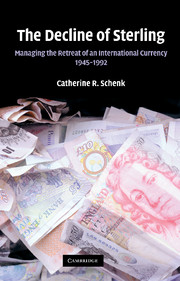Part I - Reconstructing the International Monetary System 1945–1959
Published online by Cambridge University Press: 04 May 2010
Summary
Planning during the Second World War for the organisation of the international monetary system helped to identify the key challenges that would face sterling at the end of hostilities. The accumulation of sterling debt and the increasing influence of the United States, with the emphasis on multilateral non-discriminatory trade, had a profound impact on sterling's role as an international currency. The next two chapters discuss the role that sterling played in the international monetary system and how it evolved during the prolonged rebuilding of the international monetary system from 1945 to 1959. These years were crucial to the retreat of sterling as an international commercial currency, and this was also the period when various solutions were proposed to end sterling's international reserve function. Although not publicly stated, these policies revealed that ministers and officials viewed sterling's international role with deep distrust, leading to various plans to curtail both its private and its official international functions.
- Type
- Chapter
- Information
- The Decline of SterlingManaging the Retreat of an International Currency, 1945–1992, pp. 35 - 36Publisher: Cambridge University PressPrint publication year: 2010

